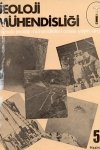
ABSTRACT: La source de l`uranium, en ce qui concerne les gisements uranifères du type filonien, peut être le magma silioique de caractère acide ou les roches mafîques. Selon certains auteurs, ce type de gisements peut se former par les processus supergènes exogéniques. Selon d`autres, au cours de la mise en place des filons d`uranium les processus hydrothermaux endogéniques jouent le rôle essentiel, II existe 4 facteurs essentiels qui contribuent à l`accumulation de l`uranium dans les grès d`origine fluviatile. Il s`agit de la présence de la roche mère qui procure de l`uranium, le transport et la déposition de l`uranium et enfin la conservation du dépôt uranifère.. L`étude comparative de différentes hypothèses émises par de nombreux chercheurs concernant ces 4 facteurs précités peut mettre en évidence les agents contrôlant la formation de ce type des formations uranifères. En outre, l`étude de la formation des gisements conglomératiques de l`uranium, les placers radioactifs, les phosphates uranifères, les schistes noirs d`origine marine, les charbons et les hydrocarbures contenant de l`uranium, peut mettre au claire les mécanismes d`accumulation de l`uranium et les facteurs qui les contrôlent
ABSTRACT: Graphite, having hexagonal crystal structure, has a high heat transmission capacity and starts burning at 3500 °C, This property opens various fields of industrial usage to graphite, especially m metal extraction and maulding Graphte which is also used as electrodes has two different forms in nature. These are nomed as mocrs,- and nicro or crypto crystalline grophite. Graphite results from high heat effects In nature and its must common types are the metamorphie ares. World graphite production is 378.000 tons per year
ABSTRACT: The dip and slope were functionally studied in respect of tangent (Fig. 1) and the results were applied on the graphic of tangent (Fig. 2). It is only after this, it is noticed that these curved contacts were possible in some limited areas, as it seems In Fig. 2 (S1( S s and S4)ı according to tangent graphics.Also, the effects of bed dips and morphological slopes to the position and condition of Hthologİeal contacts formed at toplines and valleys, studied. As it is known, up to now five positions of lithological contacts have been found out and described (Billings, M. P., 1972, Structural geology). When it is found out by writer that these two basic conditions and each condition included three positions, the sixth position is added to the contact types. The straight or curved contact lines occour the same way on the toplines as in the walleys, only direction of the curvature reverse. Each position of the contact lines has been mathematically described by a function. Thus finally some functions that are very practical m use, have been systematically explained and offered.
ABSTRACT: Results of the studies on the clay mineralogy of flysch deposits, cut by the derivation tunnel T-2 Aslantaş Dam, had shown the dominancy of hydrous mica (illite) in the sliding layer and the layer below, whereas the dominancy of chlorite in the layer above. Texturally the layers were also found to be different from each other. The differences in clay mineralogy are partly affected by the sedimentation and partly the environmental conditions (Geologic and pédologie). The formation of empty spaces due to décalcification processes caused by rainfall and the textural differences givje rise to the. formation of water saturated sliding layer- Under such conditions the amount of dynamite to be used becomes very important. A little more than sufficient amount of dynamite can cause a collapse of such structures. The flysch layers which are sometimes as much as one mUJmeter in thickness, having different clay minerals present in their clay fraction give different swelling pressure. In this respect, the pressure analysis made on the samples taken during the mechanical drilling and Shelby samples can not show satisfactory results. Therefore a study on clay mineralogy is needed on the samples taken from the flysoh layers for such structures

 TMMOB
TMMOB